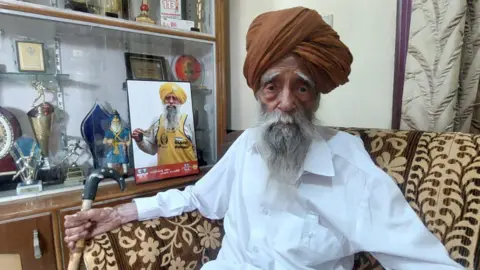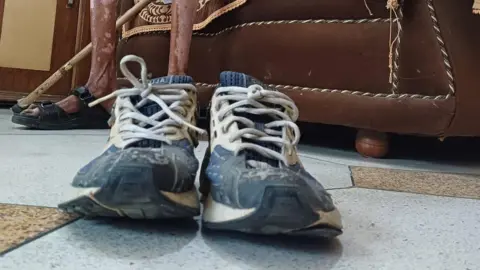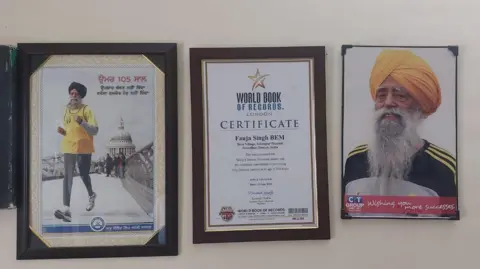BBC Punjabi
 Pardeep Sharma/BBC
Pardeep Sharma/BBCFauja Singh, a British-Indian man believed to be the world’s oldest marathon runner, has died in a road accident at the age of 114.
Singh, a global icon who was once featured in an Adidas advertising campaign, began running when he was 89 years old. He ran nine full marathons between 2000 and 2013, when he retired.
Police say Singh was walking in his village in the Indian state of Punjab when an unidentified vehicle hit him. Locals took him to the hospital, where he died.
“A search is under way, and the accused will be caught soon,” said Harvinder Singh, a top district police officer.
As news of his death broke, tributes poured in.
Indian Prime Minister Narendra Modi called him an “exceptional athlete with incredible determination”.
Singh’s running club in London, Sikhs in the City, said events they would celebrate his success and achievements through their upcoming events.
When the BBC met Singh in June in Beas Pind village, he was agile and active, walking several miles every day.
“I still go for walks around the village to keep my legs strong. A person has to take care of his own body,” he said.
A torchbearer for the 2012 London Olympics, Singh clocked several milestones during his running career, including reportedly becoming the first centenarian to complete a full marathon in 2011 in Toronto.
However, his claim of being the world’s oldest marathon runner was not recognised by the Guinness World Records as he could not show a birth certificate from 1911. The BBC reported at the time that Singh’s British passport showed his date of birth as being 1 April 1911, and that he had a letter from the Queen congratulating him on his 100th birthday.
His trainer, Harmander Singh, said that birth certificates were not made in India at the time Singh was born.
Guinness World Records officials said they would have loved “to give him the record”, but that they could only “accept official birth documents created in the year of the birth”.
As a young boy growing up in Punjab, Singh was teased by people in his village as his legs were weak and he could not walk properly until the age of five.
“But the same boy, once mocked for his weakness, went on to make history,” he told BBC Punjabi in June.
Before he turned 40, Singh, a farmer, had lived through the turbulence of both the World Wars and experienced the trauma of Partition.
“In my youth, I didn’t even know the word ‘marathon’ existed,” Singh told BBC Punjabi. “I never went to school, nor was I involved in any kind of sports. I was a farmer and spent most of my life in the fields.”
He first took to running to cope with grief.
After the death of his wife Gian Kaur in the early 1990s, he moved to London to live with his eldest son Sukhjinder. But during a visit to India, he witnessed his younger son Kuldeep’s death in a gruesome accident which left him devastated.
Overtaken by grief, Singh would spend hours sitting near the spot where his son had been cremated. Concerned villagers advised his family to take him back to the UK.
Back in Ilford in London, during one of his visits to the gurdwara, Singh met a group of elderly men who would go on runs together. He also met Harmander Singh, who would go on to become his coach.
“Had I not met Harmander Singh, I wouldn’t have gotten into marathon running,” he said in June.
 Saurabh Duggal/BBC
Saurabh Duggal/BBCSingh made his debut at the London Marathon in 2000, a month shy of turning 89. He participated through a Golden Bond entry – a system where charities pre-purchase a fixed number of spots for a fee. He chose to run for BLISS, a charity that supports premature infants. His tagline: “Oldest running for the youngest! May they live as long as him.”
Singh says that before the run, he was told by event officials that he could only wear a patka (headgear worn by many Sikh boys and men) and not a turban.
“I refused to run without my turban. Eventually, the organisers allowed me to run with it, and for me, that’s my biggest achievement,” he said.
He finished the race in six hours and 54 minutes, marking the beginning of a remarkable journey.
By his third successive appearance at the London marathon, he had shaved off nine minutes from his previous best.
In 2003, at the Toronto Waterfront Marathon, he bettered his timing by an astonishing one hour and five minutes, completing the race in five hours and 40 minutes.
“I don’t remember my timings; it is my coach, Harmander Singh, who keeps the record of all my timings. But whatever I have achieved is all because of his training, and I sincerely followed his schedule,” Singh said in June.
“In London, he used to make me run uphill, and because of that, I kept on improving,” he added. “Almost after every training session in London, I used to go to the gurdwara, where my diet was taken care of. Everyone there motivated me to run long distances.”
Singh shot to international fame in 2003 when Adidas signed him for their Nothing Is Impossible advertising campaign which also featured legends such as Muhammad Ali.
In 2005, he was invited by the then Prime Minister of Pakistan to participate in the inaugural Lahore Marathon. A year later, in 2006, he received a special invitation from Queen Elizabeth II to visit Buckingham Palace.
Among the many mementos and certificates displayed at Singh’s home in Punjab is a framed photograph of him with the Queen.
 Pardeep Sharma/BBC
Pardeep Sharma/BBCHe continued to compete in marathons well into his 100s and earned the nickname ‘Turbaned Tornado’. Most of his earnings from endorsements went directly to charitable foundations.
“I was the same Fauja Singh before I entered the world of running – but running gave my life a mission and brought me global recognition,” he recalled.
In 2013, he participated in his last long-distance competitive race in Hong Kong, completing a 10km run in one hour, 32 minutes and 28 seconds.
He credited his health and longevity to a simple lifestyle and disciplined diet.
“Eating less, running more, and staying happy – that is the secret behind my longevity. This is my message to everyone,” he said in June.
In his final years, Singh divided his time between India, where his younger son lives, and the UK.
When the BBC met him in June, he was hoping to visit London again soon to meet his family there and coach.
British MP Preet Kaur Gill, shared a photo of herself with him on X, writing: “A truly inspiring man. His discipline, simple living, and deep humility left a lasting mark on me.”
Additional reporting by from Pardeep Sharma









